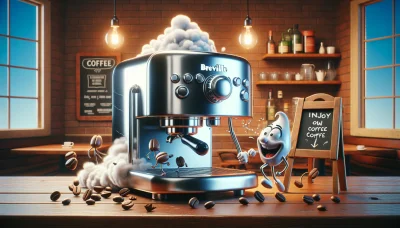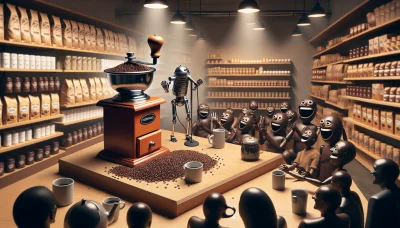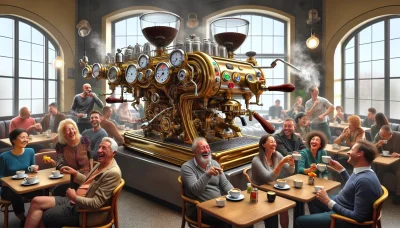Dry cappuccino Quiz
Test Your Knowledge
Question of
What is a Dry Cappuccino?
A dry cappuccino is a variation of the traditional cappuccino, distinguished primarily by its reduced amount of milk. While a regular cappuccino is made with equal parts of espresso, steamed milk, and milk foam, a dry cappuccino has the same amount of espresso but less steamed milk and more milk foam. This alteration results in a stronger espresso flavor and a lighter, airier texture compared to its regular counterpart. The term "dry" refers to the reduced liquid content in the drink, emphasizing the frothy and airy milk foam that dominates the beverage.
The History of the Dry Cappuccino
The dry cappuccino, a beloved variant of the traditional cappuccino, has a rich history that dates back to Italy's coffee culture. Unlike its wet counterparts, the dry cappuccino is characterized by a smaller amount of steamed milk and a larger proportion of milk foam, making it a favorite among those who prefer a stronger espresso flavor with a lighter, airier texture. The evolution of the dry cappuccino can be traced back to the early 20th century when coffee enthusiasts in Italy began experimenting with the balance of milk and espresso in their cappuccinos. Over time, as coffee culture spread globally, variations of the cappuccino began to emerge, catering to different tastes and preferences. The dry cappuccino gained popularity for its unique texture and the way it highlighted the espresso's robust flavors. Today, it remains a staple in coffee shops around the world, a testament to the enduring legacy of Italian coffee artistry and innovation.
How to Make a Dry Cappuccino
Follow these steps to craft a delicious dry cappuccino right in your own kitchen. You'll need a few specific ingredients and pieces of equipment to get started.
Ingredients and Equipment Needed:
- Espresso coffee beans
- Fresh cold milk (preferably whole milk for richer foam)
- Water
- Espresso machine with steam wand
- Coffee grinder
- Milk frothing pitcher
- Cappuccino cup
Steps:
- Grind your espresso beans to a fine consistency, similar to table salt.
- Fill the espresso machine's portafilter with the ground coffee, tamping it down firmly.
- Start the espresso machine and brew a shot of espresso directly into your cappuccino cup.
- While the espresso is brewing, pour cold milk into your frothing pitcher. The amount of milk should be about a third of your pitcher.
- Use the steam wand on your espresso machine to froth the milk. Aim for a thick, creamy foam with very small, uniform bubbles. For a dry cappuccino, you'll want more foam and less liquid milk.
- Once your milk is frothed to the desired consistency, tap the pitcher against the counter to break any large bubbles and swirl it gently to keep the foam creamy.
- Spoon the frothed milk onto your brewed espresso, adding as much foam as you prefer. A traditional dry cappuccino has a higher ratio of foam to milk, so aim for a thick layer of foam on top.
- Optionally, you can sprinkle a little bit of cocoa powder or cinnamon on top for added flavor.
Enjoy your homemade dry cappuccino!
Dry Cappuccino vs. Wet Cappuccino
| Aspect | Dry Cappuccino | Wet Cappuccino |
|---|---|---|
| Milk to Foam Ratio | Less milk, more foam | More milk, less foam |
| Taste | Stronger espresso flavor | Smoother, milkier taste |
| Texture | Light and airy due to more foam | Creamier due to more milk |
The Best Coffee Beans for a Dry Cappuccino
When it comes to crafting the perfect dry cappuccino, the choice of coffee beans plays a pivotal role in achieving that rich, intense flavor profile we all love. For a dry cappuccino, where the emphasis is on the frothy, almost creamy texture of the milk with less liquid, the coffee itself needs to stand out, cutting through with its robust taste. The best beans for this purpose are typically of a medium to dark roast, which provides the bold, deep flavors necessary to complement the milk's texture.
Arabica beans, known for their smooth, complex flavor profiles, are a preferred choice among baristas. Look for beans that come from regions like Ethiopia or Colombia, where the combination of altitude, climate, and soil produces beans with just the right acidity and sweetness. For those who prefer a bit more intensity and a darker chocolate note in their cappuccino, beans from Sumatra or Brazil, roasted to a darker level, can add that extra depth and richness.
Ultimately, the best coffee bean for a dry cappuccino comes down to personal preference. However, experimenting with single-origin beans or blends roasted to medium or dark levels will help you find that perfect match. Remember, the goal is to achieve a balance where the coffee's natural flavors shine through the frothy texture of the milk, creating a memorable dry cappuccino experience.
Tips for Perfecting Your Dry Cappuccino
- Start with High-Quality Coffee Beans: Choosing fresh, high-quality beans is the foundation of any great cappuccino.
- Grind Coffee to the Right Size: For espresso, use a fine grind to ensure the best extraction.
- Master the Art of Frothing: For a dry cappuccino, you want more foam and less milk. Use cold milk and angle the steaming wand to introduce air and create a rich, dense foam.
- Temperature Control: Heat your milk to about 150-155°F (65-68°C) for the optimal texture and sweetness.
- Perfect Your Pour: Pour the steamed milk and foam over the espresso carefully, aiming to have more foam than milk in the cup.
- Maintain Your Equipment: Regularly clean your espresso machine and steaming wand to ensure the best taste and proper function.
- Practice: Like any skill, perfecting your dry cappuccino takes practice. Experiment with different techniques and ratios to find what works best for you.
Where to Find the Best Dry Cappuccino
Finding a high-quality dry cappuccino can be a delightful journey for any coffee enthusiast. The key to discovering the best places is to look for cafes that prioritize the quality of their espresso and the skill of their baristas. Specialty coffee shops often offer the best experiences, as they focus on every detail of the coffee-making process, from the origin of the beans to the final pour. Chains like Blue Bottle Coffee and Intelligentsia are renowned for their espresso drinks and might be a good starting point. However, don’t overlook local cafes in your area. These hidden gems often provide unique blends and personalized service that can elevate your dry cappuccino experience. Remember, the best cafes are those that share your passion for coffee, so don’t hesitate to ask the baristas for their recommendations and insights into their coffee selection and preparation techniques.












